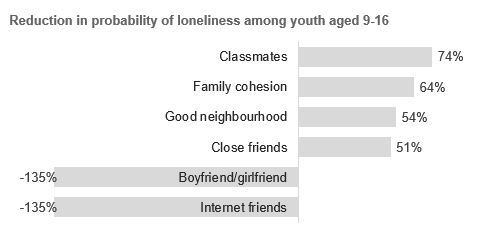Loneliness, connectivity, and place in New Zealand
Author
Rebekah Smith
Author affiliation
Victoria University of Wellington
Publication
Master’s Thesis, 2015, Victoria University of Wellington, Wellington, New Zealand
Methodology
The thesis showed that loneliness is not confined to a particular age group but is widespread across all ages, and is in fact highest among the young and declines with age. Therefore, studies of loneliness are most appropriately based on population-wide surveys. At the same time, particular attention needed to be paid to the young. For these reasons the methodology applied statistical models of loneliness to two separate data sets: the 2012 NZ General Social Survey, and a sample of youth in Wellington, Taranaki and Auckland as provided by the 2006 Youth Connectedness Project.
Results
"My primary finding has to do with the cumulative nature of connectedness. Over and above the separate effect of having a partner, local family, and friends, is the importance of their combined and cumulative effect in reducing loneliness, a feature which reinforces the importance of the concept of community." Both youth and adult connectedness decreases loneliness but with decreasing returns.
Conclusion
"There needs to be widespread acknowledgement about how loneliness affects not only the elderly, but also is common in younger populations. Public recognition could enable youth to recognise and confront their own feelings of loneliness, and will allow those close to them to notice symptoms and solutions that may not have been recognisable without this information, for example spending less time with friends online. Only then will there be a reduction in loneliness among the young."
“Loneliness may well be New Zealand’s next big public health issue.”
Loneliness among New Zealand's youth
The research, as far as we are aware, includes the first and only study of loneliness among New Zealands youth aged 9 to 16. The research showed that youth are less likely to feel lonely if they get on with classmates, have a cohesive family, live in a good neighbourhood and have close friends (see figure). On the other hand, youth are more likely to feel lonely if they have a boyfriend or girlfriend, or if they have internet friends they have not met face-to-face.

A limitation of the research was that both the 2012 NZ General Social Survey and 2006 Youth Connectedness Project used a single question to assess loneliness. In the 2012 General Social Survey the question was expressed in terms of ‘social isolation’, which is not the same as loneliness (the question was changed to ‘loneliness’ in the 2014 and 2016 General Social Surveys). A further limitation was the age of the Youth dataset. The Youth dataset was further limited by its smaller sample size of 1,866 participants versus about 8,000 participants in the 2012 General Social Survey.
Due to space limitations, the review has focused on the novel work on loneliness in youth. However, the thesis also has a very good literature review and an analysis of adults using the NZ General Social Survey 2012.
